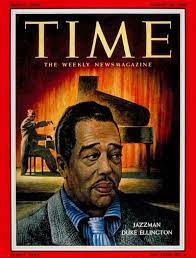Bill Cosby brought a copy of Duke Ellington at Newport to play before his benefit for New England Public Radio on Saturday night at Symphony Hall in Springfield. It was quite a thrill to enter the hall and hear the Ellington orchestra rocking behind Paul Gonsalves’s 27-chorus long solo connecting “Diminuendo in Blue” and “Crescendo in Blue.”

Gonsalves lit up Newport on that night of July 7, 1956, and Ellington’s fortunes rose dramatically as a result. For the first half of the decade that saw virtually all big band activity grind to a halt, Duke managed to keep his 15-piece ensemble on the road, but the quality of gigs declined and so did Ellington’s output as a composer and recording artist. But as John Fass Morton writes in Backstory in Blue, the Newport appearance was a turning point for Duke. He landed on the cover of Time later that year, and the Ellington at Newport album became the biggest seller of his career. “The industry buzz really began after all the write-ups about the 1956 event,” said Newport producer George Wein. “When he got on the cover of Time magazine, it gave him a second life.”

This second life coincided with a new contract with Columbia Records, where producer George Avakian encouraged the sudden outpouring of extended works and special projects that Ellington and Billy Strayhorn created over the next decade. The Shakespearian-themed Such Sweet Thunder; the television production A Drum Is a Woman; the reprise of Black, Brown & Beige with Mahalia Jackson singing the newly lyricized “Come Sunday;” the soundtrack and Duke’s cameo as Pie Eye in “Anatomy of a Murder;” The Queen’s Suite, Far East Suite, and the Sacred Concerts: all were among the landmark undertakings of the next several years.
All the while, of course, the Duke Ellington Orchestra maintained its ceaseless round of one-nighters, State Department tours, and what little remained of the more restful one- and two-week nightclub engagements that had once been a routine part of the band’s itinerary. Duke managed to include his newer works in his repertoire, but the tried and true was ever present. By the time I began hearing Ellington in the late 60’s, it had become cliche for critics to knock the “greatest hits” elements of the concerts, but there’s little to fault in this superbly shot film of a concert in Zurich. It came as part of a tour that Duke made of seven European countries in September and October 1959, and for this stop the band plays a set of familiar material with commanding ease and down-home elegance.
Highlights include the opening medley of “Black and Tan Fantasy/Creole Love Call/The Mooche,” with the clarinets of Russell Procope and Jimmy Hamilton and the bass clarinet of Harry Carney playing the Love Call theme, and Hamilton echoing Procope, followed by Ray Nance’s plunger mute declarations, on “The Mooche.” Carney smiles at the close of his clarinet chorus on “Rockin’ in Rhythm,” the 1930 stomp that he’d co-authored with Duke and played thousands of times. Trombonists Britt Woodman and Quentin “Butter” Jackson are featured on several selections, while the trumpet section of Nance, Clark Terry, Andres Meringuito, and Cat Anderson burn on “El Gato” and “Jam With Sam.” Bassist Jimmy Woode is wonderfully prominent in the mix, and Jimmy Johnson proves a worthy successor to the great Sam Woodyard on drums. Terry and Jackson left what Clark called the “University of Ellingonia” following this tour, both joining Quincy Jones for the Paris premiere of his revue Free and Easy.

This appears to be the first of two sets, in which case Newport hero Gonsalves may have been featured more prominently following the break; in the opener, he’s limited to a single, hard-swinging chorus on “Jam With Sam.” The set closes with a another medley of sorts: while Duke plays “I Let a Song Go Out of My Heart,” the horns plays “Don’t Get Around Much Anymore.” If you haven’t got time to watch the entire 45-minute show, scroll to 22:30 to watch Johnny Hodges play “All of Me.” Does anyone else come close to matching Rabbit’s combination of nonchalance and expressiveness? Listen for Duke’s brief harmonizing with the alto saxophonist on the bridge of the second chorus. It’s such little gems that made the Ellington experience nonpareil, and that kept it fresh for the cats responsible for making it sound magical night in and night out, whether in Newport or Zurich or Peoria.